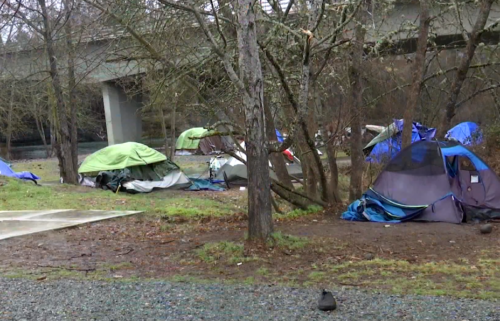Mt. Bachelor’s favored powder also poses deadly danger

(Update: Mt. Bachelor spokesman comments in wake of skier, boarder deaths)
The light, fluffy powder so many Mt. Bachelor skiers and snowboarders crave when they hit the slopes also brings with it an increased danger of someone falling into a tree well and suffocating — a rare occurrence that struck twice in a matter of hours on Friday afternoon, a spokesman said Saturday.
“When we are in a cold-weather pattern like we have been in, the new snow we get is very dry, with very little water content in it,” Marketing and Communications Director Drew Jackson explained. “So it accumulates deeply, with a lot of air in it.
“So it’s very fluffy, it’s very easy to ski — it’s very popular to ski that type of powder snow,” Jackson said. “But it also comes with the increased risk of hiding the danger of tree wells.”
There have been about 8 million skier and boarder visits to Mt. Bachelor since the last such death nearly 16 years ago, Jackson noted.
The resort spokesman said they will continue their safety education efforts and look for ways they could improve communication to guests about the hazards of tree wells and risk of suffocating in them.
In a stunning double-tragedy on the slopes, an hours-long search Friday night found the body of a Eugene woman who fell into a tree well while skiing and died — hours after a Bend man snowboarding on the slopes died after falling into a tree well in another area of the Central Oregon resort.
In the first incident, around noon, other skiers and snowboarders found a man later identified as Alfonso Braun, 24, of Bend, buried in the snow, dug him out and tried to revive him, though he was found unconscious and not breathing.
Mt. Bachelor Ski Patrol members were called to the scene and performed CPR while taking the man to the West Village parking lot.
Deschutes County Sheriff’s Search and Rescue personnel also were called to the scene and an AirLink helicopter was dispatched from Bend, but medics pronounced Braun dead around 1:15 p.m.
Mt. Bachelor officials said Braun was found in the experts-only West Bowls area, off the Northwest chairlift. Sheriff’s Lt. Bryan Husband, SAR coordinator, said the weather at the time was mostly cloudy, with light snow showers, and conditions at the time consisted of “unconsolidated powder.”
Husband said an investigation found that Braun had separated from his friends, snowboarding into an area of trees. He snowboarded into a tree well and became buried head-first in about six feet of snow, where he was later found.
About two hours later, around 3:30 p.m., Mt. Bachelor Ski Patrol received a report of a missing adult female skier who had become separated from her friends, the resort said early Saturday. Ski Patrol launched a search with Deschutes County Sheriff’s SAR.
After several hours of searching by the ski patrol and SAR, crews found the woman, identified early Saturday as Nicole Panet-Raymond, 19, of Eugene, about 8:30 p.m. in a tree well near the “more difficult” (intermediate) White Bark run, near the Cloudchaser lift. She also was pronounced dead at the scene.
Husband said cellphone forensics were used to help searchers find Panet-Raymond, buried in about six feet of snow, about 10 yards off the White Bark run. The Oregon Daily Emerald reported Saturday that she was a sophomore at the University of Oregon.
Sheriff’s detectives, assisted by the county Medical Examiner’s Office, were further investigating both accidents and analyzing the woman’s prior movements.
“Our entire mountain community is shocked and saddened,” John McLeod, Mt. Bachelor’s president and general manager, said in a statement. “To have two unrelated incidents in the same day is unthinkable. We are heartbroken, and our deepest condolences go out to the affected families and friends.”
A string of late-season snowstorms after a low-snow winter had brought thousands to the slopes of Mt. Bachelor, the nation’s sixth-largest ski resort, with 4,318 acres of lift-accessible terrain and 11 lifts.
But those who manage the slopes clearly were aware of the danger the light powder posed and pointed it out to the public. The resort Website’s “current conditions” summary on Friday included this:
“With all this new low density snow comes a reminder about tree well and snow immersion hazards. A good time to get caught up on good safety practices and always ski or ride with a buddy in eyesight if you’re headed off-trail.”
Jackson confirmed Friday’s fatalities were the first on Mt. Bachelor since May 2015, when a Bend skier, Peter Sky, 29, lost control and struck a tree.
There have been other fatal crashes over the years, including another skier, Scott Hackett, 27, who struck a tree and was killed in January 2008.
But Friday’s deaths were the first at Mt. Bachelor involving tree wells since February of 2002, when Kate Svitek, 22, of Bend, fell into one after becoming separated from friends. Her body was found in a tree well on the northwest side of the mountain nearly a month later after extensive searches failed to find her. Investigators said Svitek had fallen and her snowboard dislodged snow and ice, burying her.
Another Website about tree wells, “snow immersion suffocation” and safe skiing in the trees is at http://www.deepsnowsafety.org/
The National Ski Areas Association recorded 44 skier and snowboarder fatalities at U.S. ski areas during the 2016-17 season, up from 39 the prior year but still close to a 10-year industry average of 40 fatalities per season, or one per 1 million skier visits. Six of the 2016-17 season fatalities resulted from snow immersion suffocation, the association reported.



